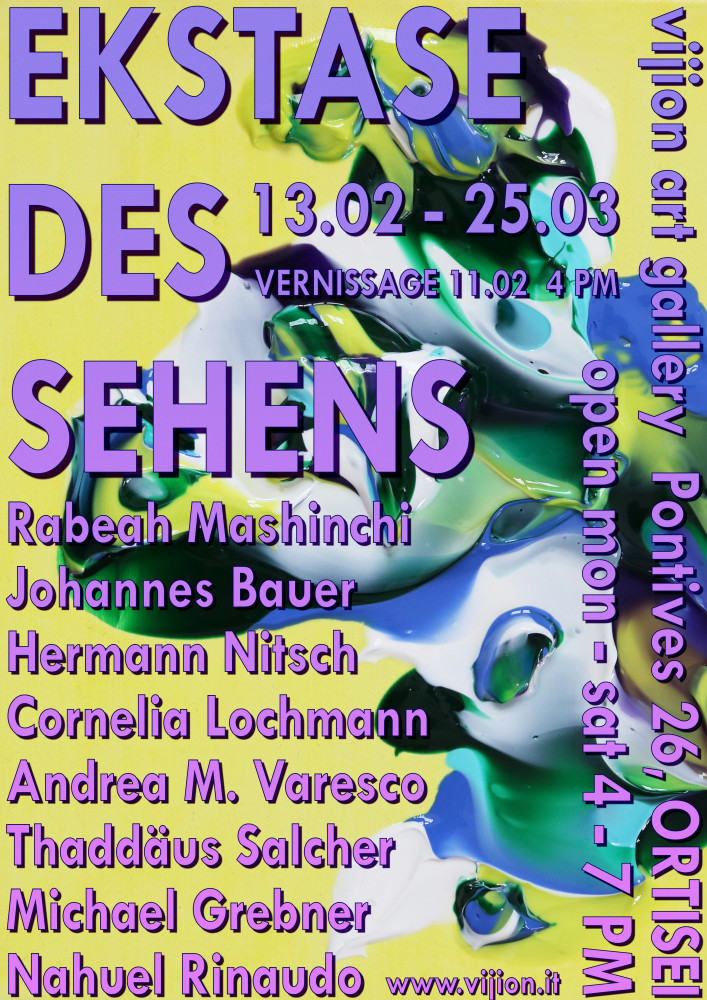Group Exhibition_Ecstasy of Seeing
Organizer: Vijion Art GalleryBased on the observation that the longing for mind-expanding experiences can be found in all societies, the exhibition aims to focus on the artistic expression of ecstasies. Ecstasy is a form of absolute surrender that leads to an intuitive and impulsive act of creation. This anthropological, universal phenomenon awakens enormous potential. Emotional impulses become images. Artists seek metaphysical trance states, the state in which the ego disappears, and the pure creative force can break through.
The technical and scientific progress of our globalised society, with progressive disenchantment of the living world, reinforces the importance of ecstatic experiences, which must be continuously renegotiated. "Ecstasies open up", according to the writer Robert Musil, "the possibility of another life; this is a justification of their seductive quality". Ecstasy is a special, immersive event for the senses, which evokes mental states of being outside oneself and leads into an anti-rational counter-world.
For thousands of years, this phenomenon has captivated people from almost all cultural circles. Strategies of ecstasy have been practised for centuries and have developed cultic forms. Since antiquity, the transcendent experience has been associated with the artistic creative process. By means of art, the confrontation with the unknown, the unknowable and intangible can be recreated and thus made more vivid. It is the epoch-spanning, repeatedly questioned assertion that art can alter perception and consciousness, thus enabling an approach to ecstatic moments. In the process, ecstasy is associated with fields as diverse as religion, the occult, inspiration, bodily experience, sexuality, drugs, or medicine, and is often intertwined with the creative act.
Ecstatic experiences can express ambivalent feelings. In ecstasy, flight and fall, elation and pain, creative urge and delusion, spiritual transgression and physical self-destruction, liberation and dependence, life and death, are always disturbingly close to each other. Being out of oneself represents a promising state that defies the required social conduct. Ecstasies are generally regarded today as an escape from the norm of everyday life.
In this interpretation, they are longed for and at the same time rejected, because it bears the danger of an individual or even collective falling out of the norm.
Whether there is any room at all today for ecstatic experiences in the narrower sense, beyond the factually rational order of everyday life and the mass spectacles staged by the media to compensate for it, remains to be seen. The visual arts are certainly one of the cultural fields that most readily allow this freedom.
About the exhibiting artists:
Thaddäus Salcher's emotive art work shows a finely detailed, meaningful painting down to the smallest detail. It reflects his personal exploration and experience.
Cornelia Lochmann's artworks show how closely the paintings, which at first seem dreamlike, are connected to the reality of her life. They take us on adventurous, unmistakable emotional experiences.
Hermann Nitsch, one of the most important representatives of Viennese Actionism, stands in the exhibition as a symbolic figure of ecstatic art. His explosive painting processes are exemplary for the freedom of emotions.
Andrea M. Varesco's manifold colour spectrum enlivens the exhibition with its atmospheric colour temperatures. The focus is on the poetic effects of light and colour.
Johannes Bauer's mystical world of colour opens up unusual, exciting possibilities of interpretation for the viewer. His works are unconditional sources of ecstatic freedom.
Beguiling colours and magical spaces are what Nahuel Leander Rinando's artworks offer us. They are complex worlds of colour in which one can get lost.
Rabeah Mashinchi's gestural paintings show a pronounced sense of colour. Fleeting perceptions and sensations are captured in colourful and atmospheric impressions.
editorially checked
Event properties
Information on participation
Misc
Exhibition information
Execution
Curator: Kostner Valentine
Introduction: Kostner Valentine
Vernissage
Künstler/in anwesend
Mit Vernissage
Startdatum: 11.02.2023
Uhrzeit: 16:00
Welcome - Opening day: Kostner Valentine


 Cookie settings
Cookie settings